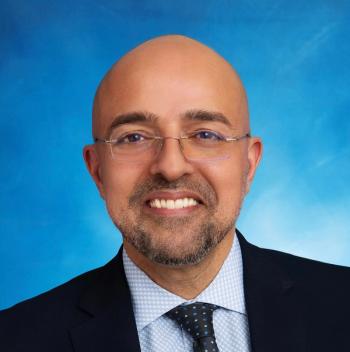
Some states are struggling with flood of COVID-19 patients in hospitals
Systems in Ohio are delaying non-urgent procedures. Hospitals across the Midwest and Northeast are packed with patients.
In Ohio, hospitals are straining amid a surge of COVID-19 patients.
Three Ohio healthcare systems - the Cleveland Clinic, the MetroHealth System and University Hospitals - jointly announced they are postponing some elective surgeries. All have seen an influx of coronavirus patients and the vast majority are unvaccinated.
University Hospitals are treating more COVID-19 patients than at any time since the pandemic began.
“Emergency rooms are very crowded,” said Dr. Daniel Simon, president of academic and external affairs and chief scientific officer at University Hospitals.
While the number of COVID-19 hospitalizations nationwide remains well below levels seen in September, states such as Ohio, Michigan and Pennsylvania are seeing more patients packing their hospitals. Some states in the Midwest and New England are seeing peaks in COVID-19 hospitalizations. New York Gov. Kathy Hochul said Monday elective procedures will be halted at more than 30 hospitals due to capacity issues.
In Ohio, University Hospitals is rescheduling non-urgent surgeries that require an overnight stay. Urgent procedures, such as surgeries for cancers or to prevent organ deterioration, are still being performed. Elective procedures that don’t require an overnight stay are still being scheduled.
The Cleveland Clinic is halting the scheduling of most non-urgent inpatient surgeries through Jan. 3, 2022. The system said it will evaluate the policy as conditions warrant.
MetroHealth said it is postponing some elective procedures and encouraging the use of its “Hospital at Home” program to free up space for patients.
More than 4,200 COVID-19 patients are hospitalized in Ohio, an 11% increase over the past week, according to the
‘Very frustrated’
The latest surge is enormously challenging and disappointing as hospital workers have endured so much stress for nearly two years, Simon said. But this new surge offers greater challenges.
Like other healthcare systems around the country, University Hospitals is facing serious staffing shortages, from nursing to nutrition, Simon said.
Nearly all the COVID-19 patients in University Hospitals have the Delta variant, Simon said. They haven’t seen any patients yet with the emerging Omicron variant. The system is seeing a pandemic-high level of COVID-19 cases, even as patients are packing the hospitals for other reasons.
The University system is seeing “significantly more flu cases” than last year, Simon said. More patients are arriving with respiratory viruses. Some patients who delayed treatment for healthcare issues due to the pandemic are coming to the hospital because they can’t wait any longer.
“You throw everything together and you’ve got a very high utilization,” Simon said.
Most of those who are hospitalized at University have not been vaccinated, Simon said. Some breakthrough cases are emerging among vaccinated patients who have had some underlying health conditions. But virtually all the system’s ICU patients are unvaccinated.
University Hospitals is projecting the peak in cases will come between Dec. 14-17. However, Simon said staff are concerned about what happens as people travel for the holidays or have family gatherings.
Ohio’s sluggish vaccination rate compounds the problems.
Ohio ranks among the nation’s ten lowest in COVID-19 vaccinations, with only 59% of the state’s residents getting at least one dose. Nationwide, 71% of Americans have had at least one vaccine dose, according to The New York Times. Simon, who recently traveled to Illinois and California, said it was startling to see how residents in those states were much more apt to take precautions, including wearing masks and social distancing.
When asked how hospital staff are weathering this new spike, Simon spoke with glowing praise about their work under adverse conditions. But he acknowledged the surge is deflating.
“They’re very resilient. We’re forever indebted to them. They’re compassionate, they’re agile and nimble. They’ll do whatever it takes,” Simon said.
Then he added, “They’re very frustrated to be in this situation.”
Simon said he hopes Ohio residents will get vaccinated and take steps such as social distancing and washing hands.
“I’m asking, maybe begging, our communities to do all the things we know that reduces transmission of the virus,” Simon said.
“Hopefully, it will help the community and everyone in the hospitals.”
‘A hospital within a hospital’
Across the border of Ohio, Pennsylvania is seeing its biggest surge of hospitalizations since January. Nearly 4,300 COVID-19 patients are getting treated in hospitals, according to data from the
In the UPMC System, hospitals are seeing an influx of COVID-19 patients and more patients with other illnesses, Don Yealy, chief medical officer, told
On Wednesday, Geisinger, one of Pennsylvania's largest health systems, said it had run out of beds in its nine hospitals due to the latest COVID-19 surge, the Associated Press reported.
Last week, Mount Nittany Medical Center, a hospital near Penn State University’s flagship campus in central Pennsylvania, temporarily diverted ambulances from its emergency department.
Dr. Upendra Thaker, Mount Nittany’s chief medical officer, said the number of COVID-19 patients is straining the hospital and others in Pennsylvania.
“Things are as challenging as they have ever been during the past 21 months of the COVID-19 pandemic,” Thaker said in a statement. “Caring for COVID patients is like operating a hospital within a hospital. It takes extraordinary resources to operate at this capacity.”
Pandemic peaks
On Monday, Michigan hit a record 4,356 COVID-19 hospitalizations,
Michigan is seeing both COVID and non-COVID patients packing hospitals and military medical teams are assisting some overwhelmed hospitals. Brian Peters, CEO of the Michigan Health and Hospital Association, spoke bluntly about the situation.
“Michigan’s health care systems are stretched beyond their limits – so much so that the U.S. Department of Defense is providing clinical staffing support to hospitals throughout the state that are operating at capacity, delaying non-emergency medical procedures and placing their emergency departments on diversion,” Peters said in a Dec. 2 statement.
Hospitals elsewhere are taking steps to deal with capacity challenges and staffing shortages. In
In Minnesota, COVID-19 patients requiring treatment in ICU reached a pandemic high Monday,
Maine has seen COVID-19 hospitalizations reach a record level this week, the







































